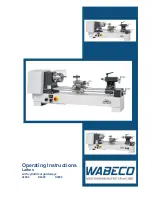
-9-
Model W1856 (For Machines Mfd. Since 02/19)
SA
FE
T
Y
Additional.Safety.for.Wood.Lathes
VERIFY.WORKPIECE.INTEGRITY
. Verify each
workpiece is free of knots, splits, nails, or
foreign material to ensure it can safely rotate
on spindle without breaking apart or causing
tool kickback.
PROPERLY.PREPARE.WORKPIECE
. Before
mounting, cut off waste portions to balance
workpiece for safe rotation and removal of
large edges that can catch on tooling.
SECURE.LOCKS
. Verify tool rest, headstock, and
tailstock are secure before turning lathe
ON
.
SECURE.WORKPIECE
. Use proven setup
techniques and always verify workpiece (and
centers/tooling holding workpiece) are well-
secured before starting lathe. Only use high-
quality fasteners with non-tapered heads for
faceplate attachment.
ADJUST.TOOL.SUPPORT
. An improperly
supported tool may be grabbed or ejected.
Adjust tool rest approximately
1
⁄
4
" away from
workpiece and
1
⁄
8
" above workpiece center
line to provide proper support for turning
tool. Firmly hold turning tool with both hands
against tool rest.
REMOVE.ADJUSTMENT.TOOLS
. Remove all chuck
keys, wrenches, and adjustment tools before
turning lathe
ON
. These items can become
deadly projectiles when spindle is started.
WEAR.PROPER.PPE
. Always wear a face shield
and safety glasses when operating lathe. Do
not wear gloves, necktie or loose clothing.
Keep long hair away from rotating spindle.
CHECK.CLEARANCES
. Before starting spindle,
verify workpiece has adequate clearance by
hand-rotating it through its entire range of
motion.
TEST.NEW.SETUPS
. Test each new setup by
starting spindle rotation at lowest speed and
standing to side of lathe until workpiece
reaches full speed and you can verify safe
rotation.
USE.CORRECT.SPEEDS
. Select correct spindle
speed for workpiece size, type, shape, and
condition. Use low speeds when roughing or
when turning large, long, or non-concentric
workpieces. Allow spindle to reach full speed
before turning.
AVOID.TOOL.KICKBACK
. This occurs when turning
tool is grabbed or ejected from workpiece
with great force. Commonly caused by poor
workpiece selection/preparation, improper tool
usage, or improper machine setup or tool rest
adjustment.
SAFELY.PERFORM.ROUGHING
. Use correct tool.
Take light cuts, use low speeds, and firmly
support tool with both hands.
USE.SHARP.TOOLS
. Sharp tools cut with less
resistance than dull tools. Using dull tools
increases the risk of tool kickback or grabbing.
SAFELY.STOPPING.ROTATION
. Always allow
rotating workpiece to stop on its own. Never
put hands or another object on workpiece to
stop it.
SAFELY.MEASURE.WORKPIECE
. Only measure
mounted workpiece after it has completely
stopped. Trying to measure a spinning
workpiece increases entanglement risk.
SANDING/POLISHING
. To reduce entanglement
risk, remove tool rest before sanding. Never
completely wrap sandpaper around workpiece.
Serious.injury.or.death.can.occur.from.getting.entangled.in,.crushed.between,.or.struck.by.rotating.
parts.on.a.lathe!.Rotating.workpieces.can.come.loose.and.strike.operator.or.bystanders.with.deadly.
force.if.they.are.improperly.secured,.rotated.too.fast,.or.are.not.strong.enough.for.the.rotational.
forces.required.for.turning..Improper.tool.setup.or.usage.can.cause.tool.kickback.or.grabbing,.
resulting.in.impact.injury.or.entanglement..To.reduce.the.risk.of.operator.(or.bystander).injury.or.
death,.anyone.operating.this.machine.MUST.completely.heed.the.hazards.and.warnings.below.












































